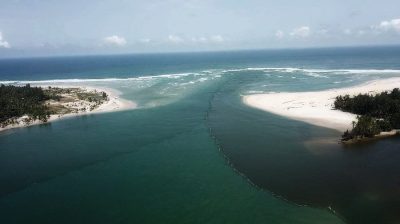
Aniaba, Louis XIV's African protégé
The appearance of an african musketeer in the second part of the film adaptation of Martin Bourboulon, The Three Musketeers: Milady (2023) aroused the questioning of certain spectators on the historical reality of his presence. Was this another production that had given in to the sirens of wokism? While a new TV series is in preparation: Black Musketeer on Disney+, we decided that it was time to demystify the subject.
By Franco | Last updated: 08/18/2024
At the origins of the Aniaba affair
To understand the source of the dilemma of this story with twists and turns, we must look at the people (*1) of the region of origin of Aniaba, the protagonist of our exciting adventure.
Aniaba belonged to the Eotilé ethnic group, a people of fishermen from a string of isolated islands in West Africa and mainly located on Assôkô-Monobaha , a large island in the southeast of Ivory Coast. Around 1670, the Éotilé welcomed on their soil allied migrant peoples in search of asylum, the Essouma, coming from of Issiny, a region of the neighboring Gold Coast (present-day Ghana). In accordance with their tradition of welcoming individuals who can participate in their economic development and more generally in their survival in the face of the ambitions of neighboring peoples, the Éotilé cede a portion of their island to newcomers.
French expansion in West Africa
In this second half of the 17th century, the African coasts are the new aspirations of European powers. France is hungry for wealth in order to replenish its coffers weighed down by wars with its European neighbors. The low returns on investments of successive Companies (West India Companies, Senegal Company, etc.) and the past failures of evangelization missions</span > in this region generated great hopes in the Compagnie de la Côte d’Or et de Guinée to establish French domination on the coasts of West Africa in the face of Dutch ambitions.
The expedition that brought Aniaba to France (1687)
In this summer of 1687 ( *2), the Tempête, this light frigate of 250 tons, 28 cannons and capable of carrying up to 150 men, sets sail, with Ducasse at its command . He had just been integrated and appointed lieutenant in the royal navy because of his many brilliant actions and his connections. He was given command of the frigate Tempête with the mission of protecting the coasts of Africa which were then plundered by pirates posing as French:
On board, religious from the Order of Saint Dominic, including Father François Gonzalves and Father Henri Cerizier with the mission of preaching the gospel and establishing missions there which had collapsed during the previous expeditions.
On their arrival in Assinie, on December 24 of the same year, the crew was received with respect by King Essouma and they were allowed for the French to settle there. We also report the presence on site during the negotiations of a certain “Knight of Amon” who will have a leading role in our story a little later. This is the ship captain Jean de Caupenne d’Amou aboard the flute La Loire then on the way to Asia. We know that Ducasse and Damon know each other well since the second served for a long time under the first’s orders.
They were entrusted with two indigenous teenagers, “judged by the missionaries to have above average intelligence” (*4): Aniaba, the young slave prince then aged around fifteen, accompanied by his cousin Banga, also of royal lineage, as a pledge of loyalty, in order to instruct and raise them in Christianity.
The arrival of Aniaba and the beginning of his life in France (1688-1691)
Thus, under the protection of the king’s favorite and the king himself, who gave him the means to lead a comfortable lifestyle, Louis Jean Aniaba lived like a young, well-educated nobleman.
And Banga in all that…
The French life of Aniaba and the ambitions we have for him (1692-1701)
The Order of the Star of Notre-Dame (1701)
Aniaba had the court painter, Augustin-Oudart Justinat, make a painting depicting him kneeling, in the presence of the king and Bishop Bossuet, receiving the mark of his order from the hands of the Holy Virgin descending from heaven accompanied by the child Jesus (*11). He donated the painting to the church of Notre-Dame in which on February 12, 1701 (*12), he is presented by Bossuet to Cardinal de Noailles on his return from Rome who officially presents him with the white cord of her order (*13). He enthroned as first knight of his order, the painter Justinat, in gratitude for the painting. The painting remained in Paris, it was exhibited for a time in the cathedral then taken down after disillusionment. He was never found.
On the way to Africa (1701)
Arrival at Assinie (1701)
On July 9, a solemn reception took place in Assôkô in the presence of the royal power and a dozen French people including Damon, Father Loyer and Aniaba as well as Banga his cousin, who we find here, as an interpreter. It seems that the Essouma appreciated that the French were at home rather than the English or the Dutch. The king insisted that Damon and Aniaba reconcile, to which Damon responded favorably, and he asked his guests the reason for their visit. To which the French, after endless courtesies, replied that they wanted to“establish the Christian faith, & to teach his subjects the way to Heaven, & together to link good commerce between its peoples & the French, their old friends, from whom they subsequently draw great help, both for their needs, and to defend them against their enemies, had attracted us from the depths of France, & bring them home, in the hope that they would respond on their part to the good intentions that His Most Christian Majesty has for them, hence Mr. Aniaba present, & the same Banga who served as our interpreter, could serve as our guarantor”. The king thanked them for their frankness and adjourned the audience.
The presents which had been transmitted by Louis XIV to Damon for the coronation of Aniaba were never given to him; they were offered to King Akasini, his brother and his nephew.
The three ships and Damon then left Assinie, on September 23, 1701, leaving our two missionaries Loyer and Villard, a governor, a lieutenant of the king, the commander De la Vie, as well as the garrison composed of 35 men to guard the fort. Dumesnil, who had been appointed commander, died as did the ship’s royal writer. (14)
The attack on Fort Saint-Louis by the Dutch (1702)
The end of the French establishment in Assinie (1703-1704)
Anabia continues his life without the French (1704-?)
In conclusion...
To make a link with the modern era, let us recall the words of King Amon N’Douffou V, king of Krindjabo, capital of kingdom of Sanwi in Ivory Coast which had already made international news in 1992 when Michael Jackson, in search of his origins, went there. The king indicated in 2019 that his kingdom shared a history with Notre-Dame Cathedral in Paris, where a prince had been baptized there in 1687. He then announced his desire to contribute to the reconstruction of Notre-Dame Cathedral in Paris following the fire: “The images disturbed my sleep and I could not spend the night, because this cathedral represents a strong link between my kingdom and France. I am in full consultation with my notables, we are going to make a donation for the reconstruction of this monument”.
Birth of Anabia
Anabia leaves Africa
Baptism
Military training
Transfer to Amiens
Death of the King of Assinie
Foundation of the Order of the Star of Notre-Dame
Departure for Assinie
Arrival in Assinie
Attack of the Dutch
Fort abandonment
Bibliography / Notes
1. Cohabitation entre les Essouma et les Eotilé à Assôkô aux XVIIe et XVIIIe siècles (2018 – Revue Performances) & Les esclaves dans les sociétés Akan de la Côte de l’Or : entre intégration parfaite et exclusion (2018 – Revue RAMRes) par Adjé Séverin Angoua
2. Relation du voyage du royaume d’Issyny : Côte d’Or, païs de Guinée, en Afrique… (1714) par Godefroy Loyer
3. Histoire maritime de Bayonne. Les corsaires sous l’ancien régime (1895) par Édouard Ducéré
4. Histoire des colonies françaises et de l’expansion de la France dans le monde (1931) par Maurice Delafosse
5. Étude sur la France maritime et coloniale par le baron Robert du Casse (1876)
6. Relation du voyage du royaume d’Issyny : Côte d’Or, païs de Guinée, en Afrique… (1714) par Godefroy Loyer
7. Notre librairie (1987) Clef
8. Correspondance de Bossuet Janvier 1701-octobre 1702 (1909-1925) | Jacques Bénigne Bossuet
9. Relation d’un voyage fait en 1695, 1696 et 1697 aux côtes d’Afrique, détroit de Magellan, Brésil, Cayenne et isles Antilles, par une escadre des vaisseaux du Roi, commandée par M. de Gennes (1699) par François Froger
10. Bulletin de la Société de l’histoire de Paris et de l’Ile-de-France | 1910 (Société de l’histoire de Paris et de l’Île-de-France
11. Les dernières années de Bossuet (1928-1929) par François Le Dieu
12. Catalogue analytique des archives de M. le baron de Joursanvault (1838)
13. Recueil de tous les costumes des ordres religieux et militaires avec un abrégé historique (1778) par Jacques-Charles Bar
14., 15. Archives historiques de la Saintonge et de l’Aunis (1930)
16. Effects of the Atlantic Slave Trade on Some West African Societies (1975) par Albert Van Dantzig
· Royaume Essoua d’Assinie – royaumeessoumadassinie.com
· Histoire générale des voyages, ou Nouvelle collection de toutes les relations de voyages par mer et par terre qui ont été publiées jusqu’à présent dans les différentes langues. (1746-1801) par John Green, Antoine François Prévost, Étienne-Maurice Chompré…
· Dix ans à la Côte d’Ivoire (1906) | François-Joseph Clozel
· Prince Aniaba. Le mousquetaire ivoirien de Notre-Dame de Paris (2023) | Serge Bilé
Photo credits
1. Carte particulière de la partie principale de la Guinée située entre Issini et Ardra par le Sr d’Anville (1729) – Bibliothèque nationale de France







